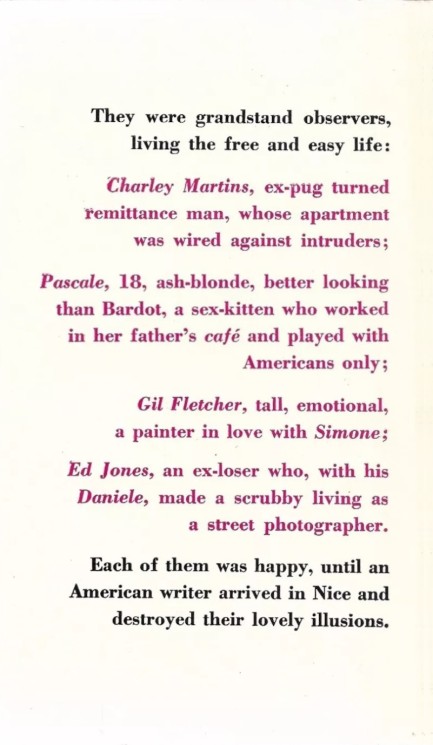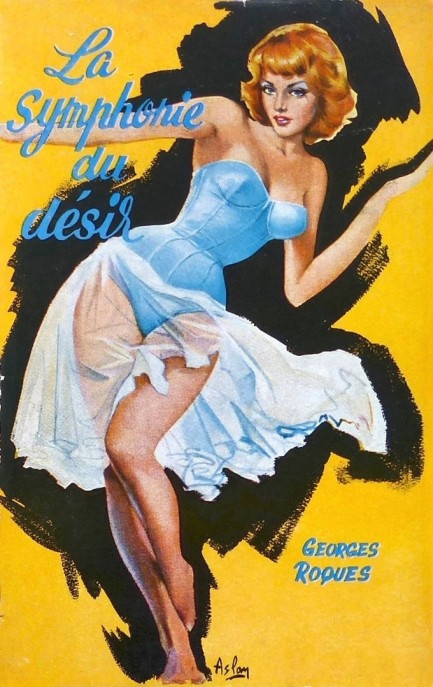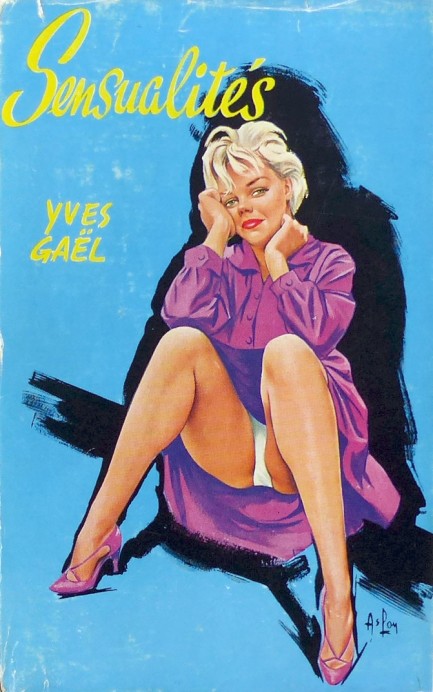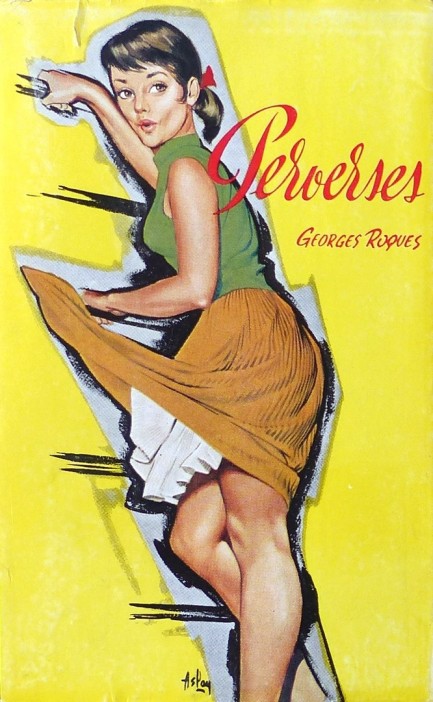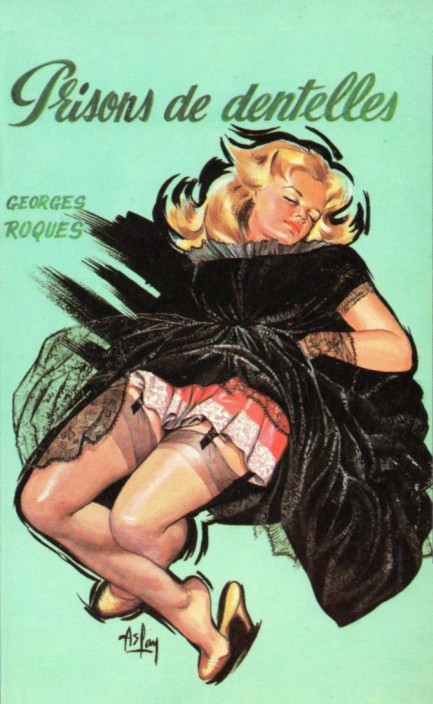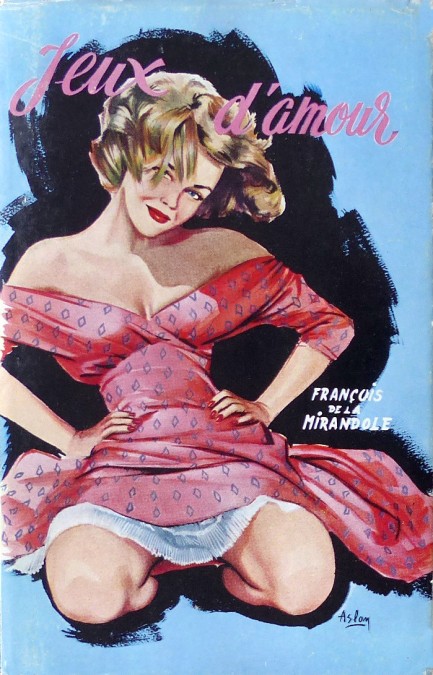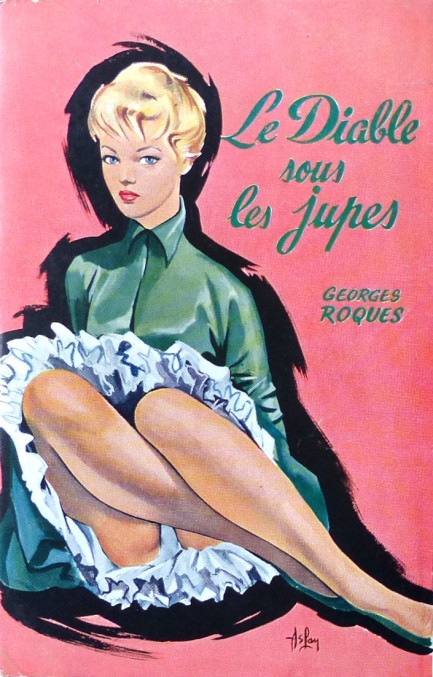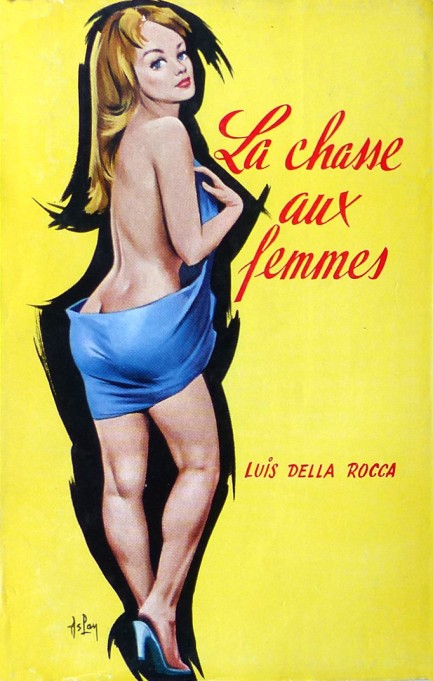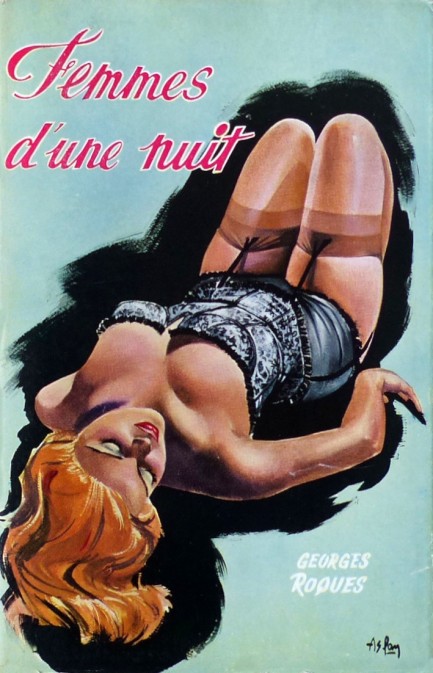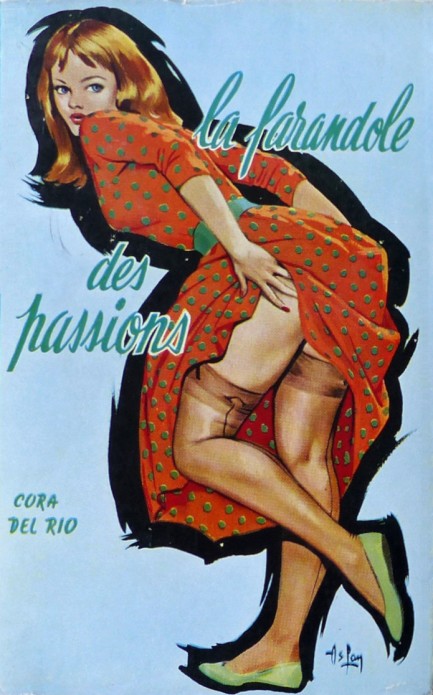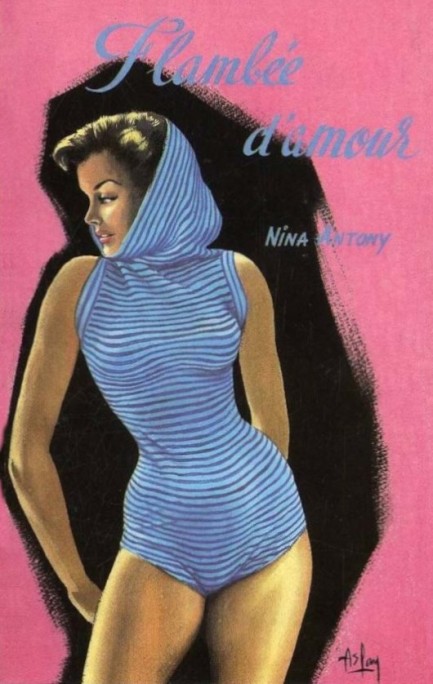 I'm starting to get a very bad feeling about this. 
This beautiful dust jacket for Mark Derby's The Tigress was painted by the very talented British artist John Rose for William Collins Sons & Co. in 1959. You'll remember that we already did a deep dive into Mark Derby's Womanhunt a bit ago. This is the same novel under its original title. Interesting, isn't it, that for U.S. readers the decision-makers at Ace Books thought Womanhunt was a better title? In any case, it's a very good novel.
 Hi there, convict. How'd ya like to perform a cavity search for a change?  
We've been eyeing a Russell Trainer novel called His Daughter's Friend for a while. It has one of illustrator Paul Rader's best covers. But since it's a pretty empty feeling to buy a book with a nice cover that turns out to be terribly written (often the case with sleaze novels), we wanted to sample Trainer's prose. With the price of His Daughter's Friend running as high as $200.00, a trial run was needed on cheaper books. Incidentally, we'd never pay that for a book anyway, but if Trainer can write, we'd probably go as high as $30.00, if we ever found a copy at that price. We ended up buying two Trainers, both at around fifteen bucks. You see the first above—Jail Bait. It's an Australian edition published by New Century Press without a copyright date or cover artist attribution. Originally it appeared in the U.S. and Canada in 1962 as The Warden's Wife.
That title pretty much sums up the idea behind the book, as a felon named Eddie Koski, after three years in max, is made a trustee and given a form of freedom as he works around the prison for the warden and other high ranking corrections officials. Unfortunately, the warden's smoking hot wife Thelma is keenly interested in working Eddie's shlong, which, of course, can only lead to trouble, if not more jail time. Things become doubly complicated when Eddie falls for a beautiful sociologist who comes to the prison to work on a dissertation. Can he escape the clutches of the dangerous Thelma and find love and freedom? Perhaps. The book is fun for the most part, but we'd have preferred the story to conclude without its late turn toward vicious homophobia. We weren't surprised when it happened, though. Consider yourselves forewarned.
Overall, we wouldn't say Jail Bait is either great or awful, which means Trainer probably will fail to add value to His Daugher's Friend. While we often buy books entirely for the cover art, we never buy expensive ones for that reason. What we love is a book that surpasses our expectations, like, for example, Val Munroe's surprisingly good 1952 sleazer Carnival of Passion. We suppose requiring decent writing skill with the cover art makes us amateurs at the book collecting game, but we're not really collectors anyway. We'll never sell them, in all likelihood. Nearly all the buyers would be in the U.S., and mailing them overseas, even at a profit, is too much work to even contemplate. So we'll give up our quest for His Daughter's Friend unless Trainer knocks book two—1963's No Way Back—completely out of the park. We'll read it in a bit and see where matters stand. 
 Darlin', that what happens here stays here stuff is baloney. What happens next—I guarantee—will stay with you forever. 
Above: uncredited sleaze cover work from Nite Time Books for Scott Rainey's 1964 alternative lifestyle romp Las Vegas Lesbian. The back says: She was a beautiful desirable woman in a gambling town loaded with women. But there was a difference. She wanted to destroy every man—and woman—who wouldn’t play the game her way! Our advice: play the game exactly as she wishes. It would be the only game in Vegas where both sides win.
 Waugh elevates missing person procedurals to a new level. 
Reading mid-century crime and adventure novels has been a great journey for us. We can imagine those who've already read them smiling (or smirking) as we discuss the books as revelations. “These pulp guys. *eye roll* ’Bout seventy years late with their stunning insights.” But that's the way it goes—you have start sometime. Over the years we've gone from novice to slightly-less-novice in this realm.
We say all that because, though Hillary Waugh is a well-known novelist, up to this week we'd read only one of his books—1960's The Girl Who Cried Wolf. It's a personality-driven, occasionally cute tale, about a tough P.I. and the collegiate client who has a massive crush on him. The book is pretty much a total success. There was no logical reason for us think that single effort defined Waugh's style, but experience has shown that a good novel tends to sits in the sweet spot of an author, and they hit those notes again and again.
Imagine our surprise, then, when we read 1954's Last Seen Wearing and discovered that it's a stark police procedural allegedly inspired by the true 1946 disappearance of 18-year-old Bennington College student Paula Jean Welden. What Waugh produces is basically impossible to put down. If you like police procedurals, read this one. Waugh wows. Also wow is the cover art on the 1960 Great Pan edition. Uncredited though.
 I want this to be good, you two. So take one more look over here to remind yourselves what you're fighting about. 
Last time we read a novel by the globetrotting Ed Lacy, we said afterward we'd travel anywhere with him. In 1961's The Freeloaders, for which you see a beautiful but uncredited cover above, he once again conducts readers to an exotic place—the Côte d'Azur, in the company of a small clan of Americans trying to survive without work visas in and around Nice. Freelance writer Al Cane, the most recent addition to the group, has occasional gigs and makes enough money to live. Ex-boxer/ex-cop/ex-advertising man/constant enigma Charley Martins has savings that keep him in a nice seafront apartment. But painter Gil Fletcher and inveterate schemer Ed Jones struggle daily. The women within the group are diverse. Charley's girlfriend Pascale is young, beautiful, and precocious; Gil's partner Simone is opportunistic and fickle; Ed's girlfriend Daniele is industrious and kind.
Eventually, Gil, desperate to stay in Nice and in need of money for he and Daniele, cooks up a foolproof robbery scheme. But to quote Mickey Rourke in Body Heat, "Any time you try a decent crime, you got fifty ways you're gonna fuck up. If you think of twenty-five of them, then you're a genius." Gil is no genius. The rest of the story deals with the aftermath of the crime on the Nice guys, the unraveling of the mystery of who the mysterious Charley really is, and Al's growing lust toward Pascale. As with other Lacy novels, the flavor is as important as the plot, and he dishes up the South of France (with sides of Italy) in satisfying fashion. There are always a few nits to pick with him. Any time you write a novel there are at least fifty ways to fuck up. Lacy is no genius, but he always entertains. That's travail numéro un.
 Murder hates company. 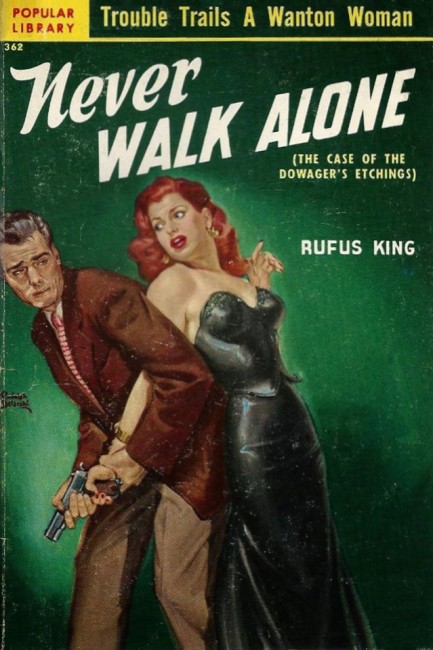
Rudolph Belarski, whose work is always instantly recognizable, painted this cover for Rufus King's 1944 mystery Never Walk Alone, earlier known as The Case of Dowager's Etchings. The change tells you that Popular Library thought a less old-fashioned title would boost sales for this 1951 re-issue. But the old-fashioned nature of the story is a feature, not a bug. What you get is intrigue at the residence of Carrie Giles, who's opened her large home up as a boarding house called River Rest and had the rooms filled by workers in an arms factory.
Giles is a throwback who's still driven around by horse and carriage in an era of cars and planes. The tale is told from her point of view, and never has a more self-contained observer been committed to the printed page. This derives from her belief in politeness and decorum. Even if you're a bit nosy, as she is, you don't make a fuss. When she finds a body on her grounds she simply leaves it there for someone else to stumble across the next afternoon. Maybe she's not such a throwback after all—we can see that happening even today, so she's an interesting figure created by King.
Her genteel nature is summed up in a passage about Humphrey Bogart. Don't forget that Bogart was a famous film villain before he altered the trajectory of his career. Giles knows only the early Bogart, and is horrified when someone compares one of her boarders to Humphrey: Mrs. Giles shut her eyes. She was fairly familiar with Mr. Bogart's characterizations on the screen, and to have any one of those blood-throttling roles in the house was the last straw.
Can a mystery be fun when told from the point of view of a hidebound busybody? Turns out it can. While other elements of the story are interesting too (she thinks the murder has to do with wartime spies, and particularly suspects an outspoken and modern-minded female guest), Mrs. Giles is ultimately such a fascinating and delicate creation that it was her who kept us turning pages. Never Walk Alone isn't for readers seeking fireworks and sexual intrigue, but as an example of a character-driven mystery, it worked fine.
 Extreme volatility in the creepy old manor sector forces many from their homes. 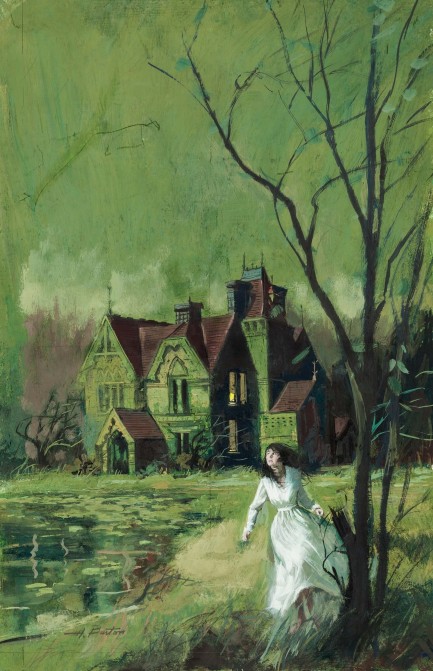 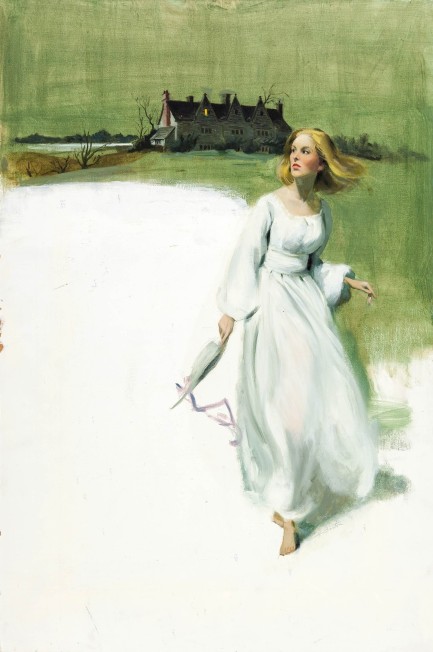 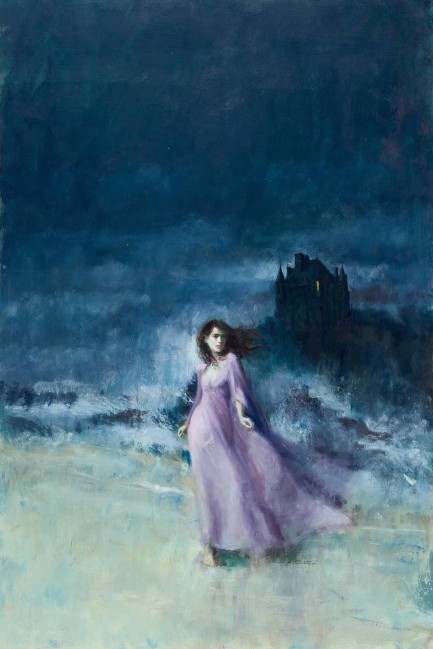 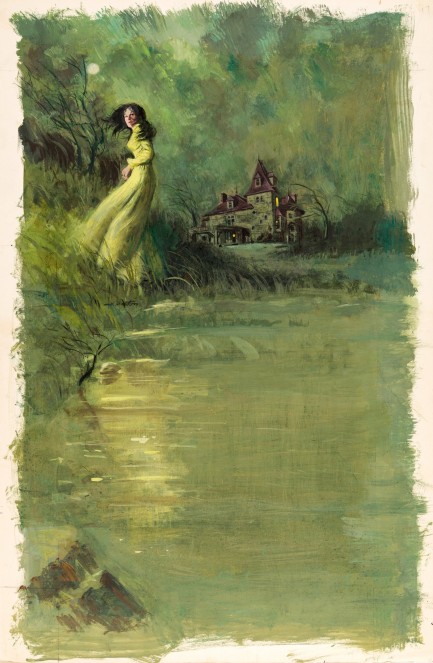  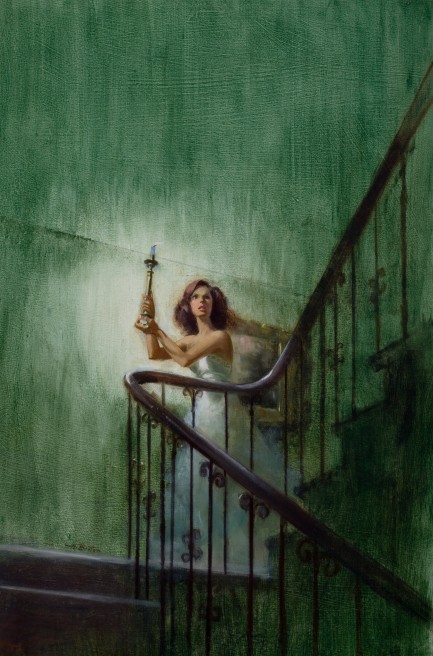 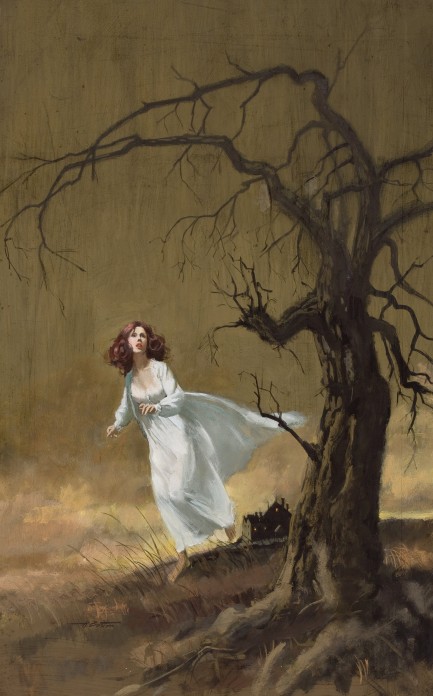 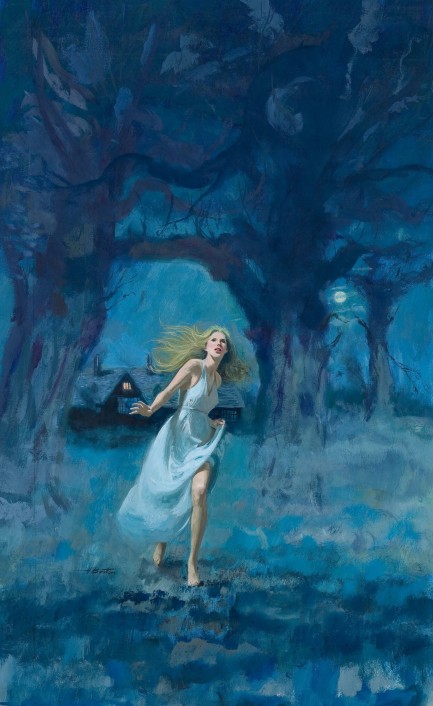 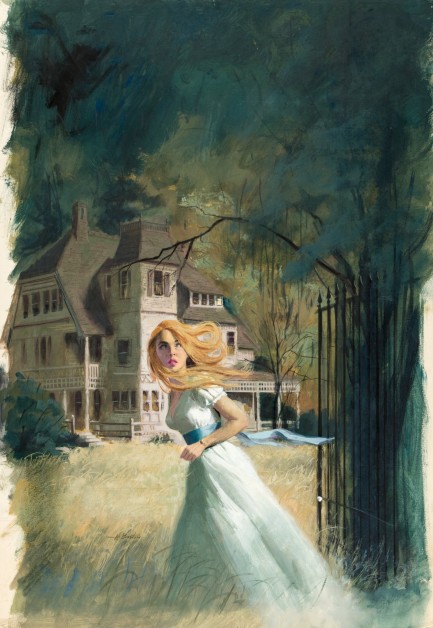 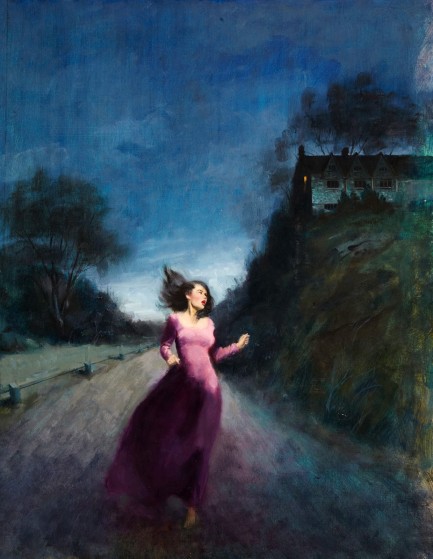 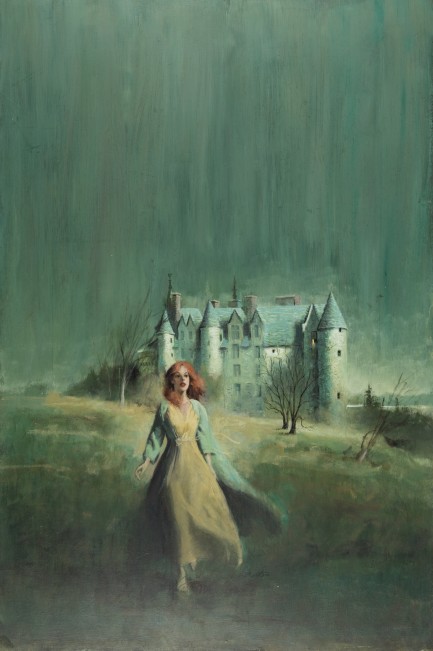 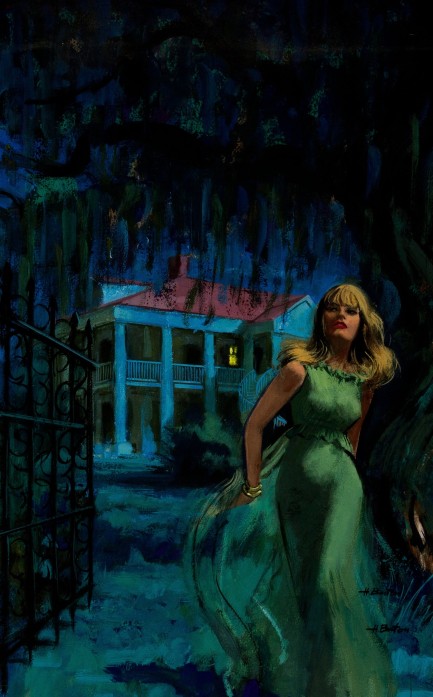 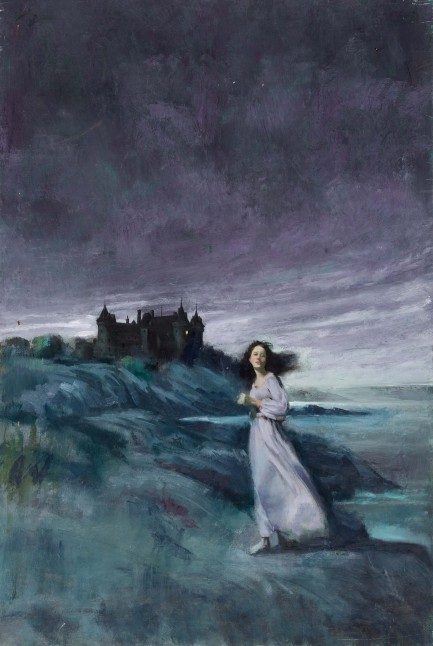  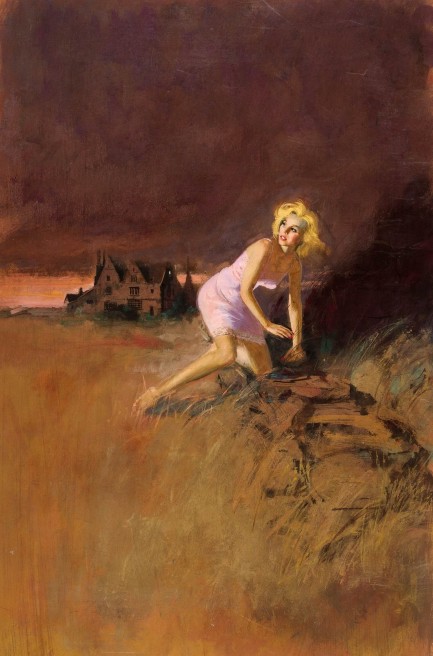 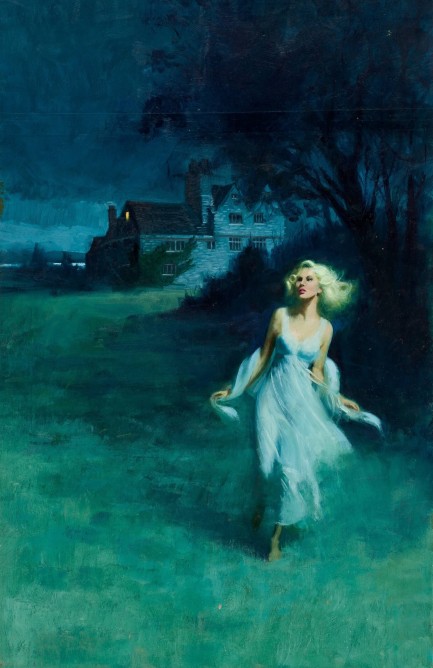  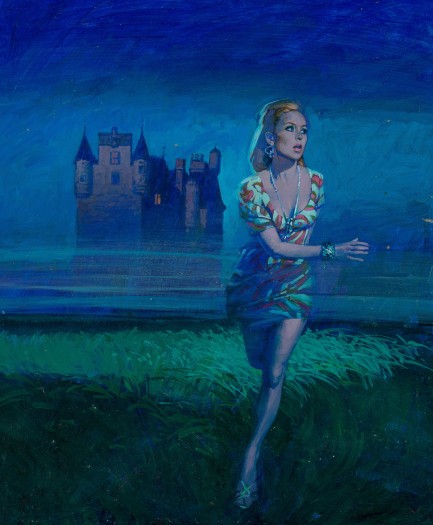 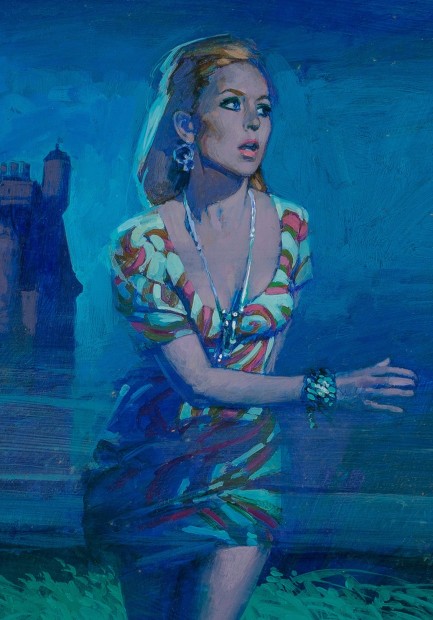
It's the worst case scenario. You're forced out of your home in the middle of the night with only the clothes on your back. As recent home buyers, that thought is a nightmare for us. In our case, it would be bankers sending us out the door. But in romance novels it's husbands, crooks, ghosts, or just bad vibes. These are all paintings by Harry Barton made for the covers of gothic romances, which we came across while trying to find out who painted the front for The Minerva Stone, a book we talked about last month. That brilliant piece is the one just above (and we've added a zoom so you can see the details of the work). It surprised us that Barton specialized in gothic romances, but it shouldn't have—he could do anything. Look at more examples of his ability here, here, and here.
 Look at that view, men! Just think how much money a trip like this would cost us if we were civilians! 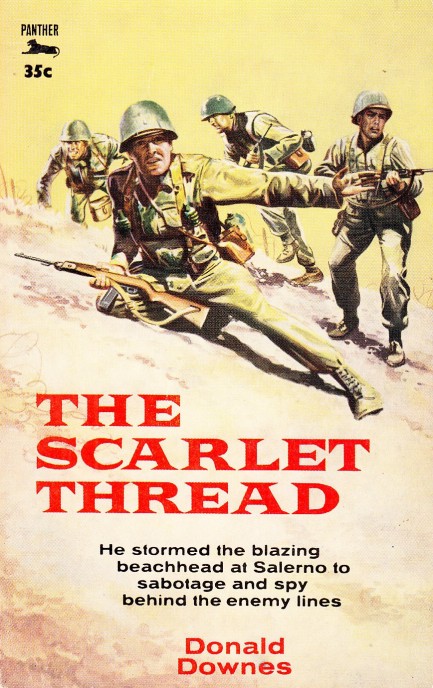
Donald Downes' World War II combat and espionage novel The Scarlet Thread originally appeared in 1953, with this Panther Book edition coming in 1959, adorned with cover art from an unknown. Like many mid-century war novelists, Downes saw it all firsthand. He was in the Office of Naval Intelligence (ONI), the British Security Coordination (BSC), and the OSS (we don't need to decipher that one, right?), and saw action against the fascists in Italy and Egypt. This novel, his first, draws on those experiences in telling the story of an aviator sent on a mission to eliminate a suspected double agent. Its French translation won Downes the 1959 Grand Prix de Littérature policière. Mission accomplished.
 Freud probably never imagined they could be used for gambling. 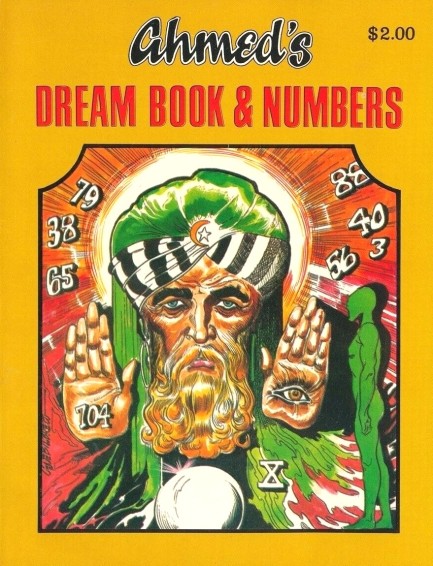 
We're down to the last of our dream books with cover art by Gene Bilbrew. This one, Ahmed's Dream Book & Numbers, was published in 1972 by the Wholesale Book Corp. It never occurred to us before, but these could be considered cousins of Freudian psychoanalysis, which was laid out in Freud's 1899 tome The Interpretation of Dreams, and helped legitimize the long held concept that dreams have meaning. Of course, his idea of meaning was that they gave insight into the subconscious mind, while a dream book's idea of meaning is that of prognostication for gamblers. We doubt Freud ever dreamt of anything like that. You can find out more about these books, and see more art from Bilbrew, by clicking this link and going down the subsequent rabbit hole.

|
 |

The headlines that mattered yesteryear.
2003—Hope Dies
Film legend Bob Hope dies of pneumonia two months after celebrating his 100th birthday. 1945—Churchill Given the Sack
In spite of admiring Winston Churchill as a great wartime leader, Britons elect
Clement Attlee the nation's new prime minister in a sweeping victory for the Labour Party over the Conservatives. 1952—Evita Peron Dies
Eva Duarte de Peron, aka Evita, wife of the president of the Argentine Republic, dies from cancer at age 33. Evita had brought the working classes into a position of political power never witnessed before, but was hated by the nation's powerful military class. She is lain to rest in Milan, Italy in a secret grave under a nun's name, but is eventually returned to Argentina for reburial beside her husband in 1974. 1943—Mussolini Calls It Quits
Italian dictator Benito Mussolini steps down as head of the armed forces and the government. It soon becomes clear that Il Duce did not relinquish power voluntarily, but was forced to resign after former Fascist colleagues turned against him. He is later installed by Germany as leader of the Italian Social Republic in the north of the country, but is killed by partisans in 1945.
|

|
|

It's easy. We have an uploader that makes it a snap. Use it to submit your art, text, header, and subhead. Your post can be funny, serious, or anything in between, as long as it's vintage pulp. You'll get a byline and experience the fleeting pride of free authorship. We'll edit your post for typos, but the rest is up to you. Click here to give us your best shot.

|
|












